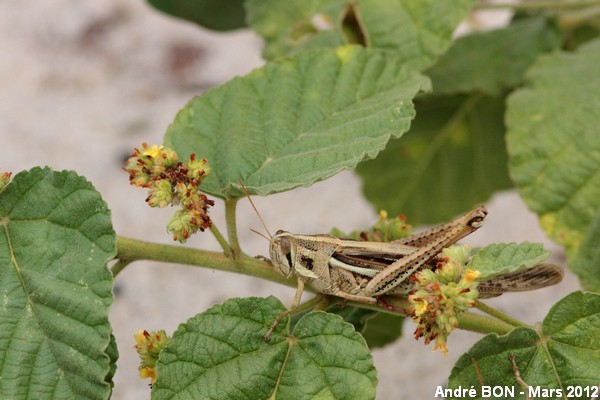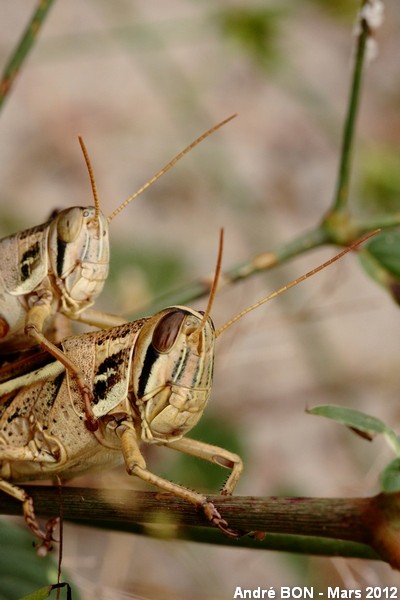


| American Grasshopper (Schistocerca americana (Drury, 1773)) |



|
|
Scientific name: Schistocerca americana (Drury, 1773) Common name: American Grasshopper Other names: American Bird Grasshopper French name: Order: Orthoptera Family: Acrididae Wingspan : Males: 39 to 45 mm; Females: 42 to 55 mm. Biotope: Cultivated areas, open woodlands. Geographic area: Central and eastern North America, Central America and north of South America. Observation period : Schistocerca americana over winters at the adult state and there can be two generations per year. |
Grasshoppers of the Schistocerca genus can be classified into about 50 different species. Only the Desert Locust Schistocerca gregaria is found in the old world, that's to say Africa, Asia and Europe. All the other species are found in the Americas. Schistocerca americana shows antennae whose length is approximately equal to the length of the head plus the length of the pronotum. The median carina on the pronotum is thin and not elevated. The tegmina exceed the tip of the abdomen by more than the length of the pronotum. They are translucent with large black spots, clearly visible on the whole length though they are smaller at the tip. The pronotum shows a creamy yellow dorsal stripe on its full length, running from the head to the tegmina. The sides are marked by dark brown stripes, usually two. The hind legs tibiae are reddish. The proliferation of these locusts may cause damages to the vegetation. There is a possible confusion with other members of the genus like Schistocerca nitens.This last one is rather greyish while Schistocerca americana is more yellowish. Schistocerca nitens often shows only one dark stripe on the side of the pronotum and one dark band near the top of the hind femur. This femoral band is missing on Schistocerca americana. Variations of colours in each species make it difficult to tell species apart without a close exam of the genitalia. Furthermore I have found some contradictory information about the geographical ranges of these different species. |
| [To know more about the American Grasshopper] [Next picture] [Top] |

|
I have shot this picture at Awala Yalimapo in a garden just bordering the WWF centre dedicated to the protection of sea turtles. I have done my best to try to tell the species apart. I think that the Schistocerca americana species is very probable but not certain. |
| [To know more about the American Grasshopper] [Next picture] [Previous picture] [Top] |

|
Mating. This picture makes me a little doubt on the identification of the species as the key indicates that the tegmina clearly exceeds the end of the abdomen, more than the length of the pronotum. This is not the case for the male on this picture. Having not found any confirmation of this part of the key in diverse photo galleries, I have let these grasshoppers listed as Schistocerca americana instead of Schistocerca sp. |
| [To know more about the American Grasshopper] [Previous picture] [Top] |

|
Close-up view on the grasshoppers' faces. The female's eyes are clearly striped vertically (this is much more visible on the non-reduced picture). This is less obvious or even missing on the male. |